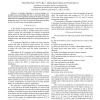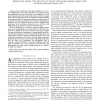39 search results - page 2 / 8 » Reducing bus delay in submicron technology using coding |
IOLTS
2003
IEEE
13 years 10 months ago
2003
IEEE
On-chip global interconnections in very deep submicron technology (VDSM) ICs are becoming more sensitive and prone to errors caused by power supply noise, crosstalk noise, delay v...
ISLPED
2005
ACM
13 years 11 months ago
2005
ACM
In this paper, we propose joint repeater insertion and crosstalk avoidance coding as a low-power alternative to repeater insertion for global bus design in nanometer technologies....
ASPDAC
1995
ACM
13 years 9 months ago
1995
ACM
A heuristic algorithm for a given topology of a multiple-source and multiple-sink bus to reduce the signal delay time is proposed. The algorithm minimizes the delay by inserting bu...
ICCAD
2000
IEEE
13 years 9 months ago
2000
IEEE
Abstract— Deep submicron technology scaling has two major ramifications on the design process. First, reduced feature size significantly increases wire delay, thus resulting in...
DAC
2004
ACM
14 years 6 months ago
2004
ACM
As process technology migrates to deep submicron with feature size less than 100nm, global wire delay is becoming a major hindrance in keeping the latency of intra-chip communicat...



